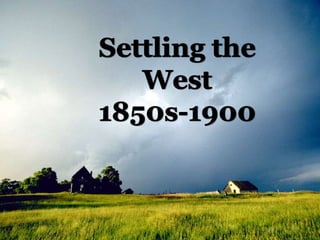
8 settling the west
- 3. Mining Centers Virginia City Comstock Lode City of Comstock Lode: Frontier City to BOOM TOWN. Had an Opera house and first 6 story hotel that had and ELAVATOR!
- 7. Prospecting The Gold Rush Swarmed in… all looking to get RICH overnight!
- 8. • Dry farming Allows cultivation of arid (dry) land by using drought-resistant crops and various techniques to minimize evaporation.
- 9. Invention of Barbed Wire Joseph Glidden
- 10. •Barbed wire fence was a lifesaver because of the lack of wood in the dry plains of America. •Barbed wire also solved the problems between farmers and ranchers.
- 11. Allowed farmers to cut through dense, root-choked sod. Steel Plow
- 12. Reduced labor force needed for harvest. Allows farmers to maintain larger farms. Mechanize d Reaper
- 13. Powers irrigation systems and pumps up ground water. Steel Windmill
- 14. Homestead Act was a law developed in 1862 by Congress to promote settlement of the Great Plains. Age 21 and the head of the family could have 160 acres of land if they improved it in five years Could buy it for a small amount of $$$ The US Government encouraged westward expansion and the Homestead Act allowed thousands of settlers to move west and start new lives.
- 17. A Pioneer’s Sod House, SD
- 20. Population Changes in the West, 1850 to 1900
- 21. •May 10, 1869 at Promontory, Utah •“The Wedding of the Rails” •Central Pacific and Union Pacific •Government supported speedy construction by giving LAND GRANTS to RR Co.
- 22. Promontory, Utah
- 24. Transformation of the West: 1st Transcontinental RR http://www.youtube.com/watch ?v=TJHAa2u9t-0
- 27. Tribes of the Great Plains Sioux Cheyenne Crow Arapaho Kiowa
- 28. Map 13 of 45
- 29. •Massacre of Buffalo •Take away the food source from the Native American and they will be forced to submit and go to the reservations. Skull
- 30. •1871 to 1875, the US supported the extermination of 11 million buffalo.
- 31. Differences in land ownership Railroad Settlers trespassing on Indian Land Discovery of gold Slaughter of the buffalo Broken treaties clash
- 32. Dawes Act of 1887 Quicker Americanization Assimilate, mainstreamed and absorbed into US society Adopt Christianity and White education Individual land ownership Abandon tribe, culture and become farmers Male claimed 160 acres of land Children would be sent to Indian schools Farm land for 25 years. 1924 gain citizenship and right to vote
- 33. Indian Assimilation Attempts • Native American children were taken to off-reservation Indian schools where they would be taught white man’s ways. • ASSIMILATE- To absorb one into a culture
- 34. Dawes Act (1887) Carlisle Indian School, PA
- 36. •Discovery of gold was often on Indian land. •Some of the key battles fought were around the mining areas.
- 37. Gold! Gold discovered in the Black Hills. Govt. tries to purchase the land, but the Sioux refuse. Gold fever and miners refuse to respect Sioux land….. Conflict erupts! There goes the neighborhood!
- 38. Sitting Bull and Crazy Horse Sitting Bull (Sioux) and Crazy Horse (Cheyenne) were two chiefs who refused to sign the treaty. They defiantly left the reservation. "One does not sell the earth upon which the people walk" Crazy Horse
- 39. Little Big Horn River, Montana - 1876 George Armstrong Custer was sent to force the Sioux, Cheyenne and Arapaho back to their reservations. He was in command of the 7th Calvary. June 26, 1876
- 40. The Battle of Little Big Horn 1876 He was heavily outnumbered and trapped. Custer & all 220 of his men died. “Custer’s Last Stand” outraged Americans and led to govt. retribution. The Sioux and Cheyenne were crushed within a year.
- 41. Little Big Horn
- 43. Little Bighorn
- 45. Battle of Wounded Knee • Last of the Indian Battles • “Ghost Dance”-sacred ritual expressing a vision that buffalo would return and the white man would vanish • On the morning of December 29, 1890 the troops went into the camp to stop the “Ghost Dance” fearing it would cause an uprising • ~200 men, women, and children, as well as some of their own fellow soldiers.
- 46. Helen Hunt Jackson (1830-1885), activist for Native American rights and author of Century of Dishonor (1881) Heightened public awareness of the federal government’s long record of betraying and cheating Native Americans. When Jackson sent a copy to every member of Congress with the following admonition printed in red on the cover: "Look upon your hands: they are stained with the blood of your relations."
- 47. •1890United States Census Bureau announced the official end of the frontier. •In 1893, historian Frederick Jackson Turner claimed that the frontier had played a key role in forming the American character. •The Turner Thesis, stated that frontier life created Americans who were socially mobile, ready for adventure, bent on individual self-improvement, committed to democracy and able to withstand difficult times to accomplish the American Dream… Frederick Jackson Turner “RUGGED INDIVIDUALIST” The frontier created the American character of one who was self-sufficient, persistent and able to withstand difficult times to accomplish the American Dream…
- 48. Frontier Life comes to close 6.07